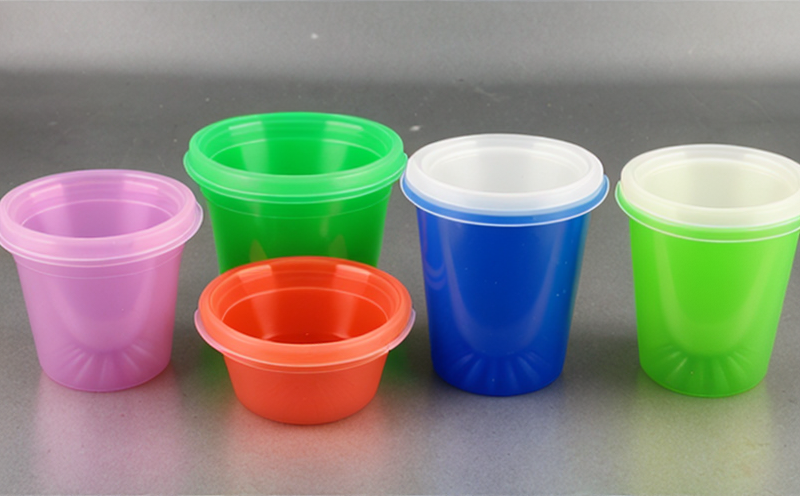ASTM D3985 Oxygen Transmission Rate Testing of Disposable Plastics
The ASTM D3985 test method is a critical procedure used to determine the oxygen permeability of materials commonly found in disposable plastics, such as packaging films and containers. This test is essential for ensuring that products meet specific performance requirements set by regulatory bodies like the FDA (Food and Drug Administration) and EU standards.
The oxygen transmission rate (OTR) measures how much air can pass through a given material over time under controlled conditions. In the context of disposable plastics, this parameter helps manufacturers assess whether their product will maintain its integrity during storage or use. For instance, if you're developing a new medical device packaging material, understanding the OTR is crucial to prevent degradation from excessive exposure to oxygen.
The ASTM D3985 test follows specific protocols outlined in the standard. It involves placing a specimen between two chambers with one chamber containing pure oxygen while the other contains nitrogen. Over time, oxygen diffuses through the sample into the nitrogen-filled chamber where its concentration is monitored using an infrared sensor. The rate of change in oxygen concentration provides the OTR value.
Specimen preparation for ASTM D3985 requires careful attention to detail. Samples must be cut to standard dimensions and thicknesses specified by the test method. It's important that these samples are representative of the final product, ensuring accurate results. Preparing multiple samples allows for statistical analysis and minimizes variability.
Once prepared, the specimens undergo conditioning in a controlled environment prior to testing to ensure they reach equilibrium with their surroundings. This step is vital because temperature fluctuations can significantly affect the OTR measurement. Proper conditioning ensures consistent test results across different batches or lots of material.
The instrumentation used for ASTM D3985 includes an oxygen permeation tester equipped with sensors capable of measuring small changes in oxygen concentration accurately. These testers are calibrated regularly to maintain precision throughout testing cycles. Calibration certificates should be kept on file along with other quality assurance documentation.
Acceptance criteria vary depending upon the intended use of the material being tested but generally fall within a range agreed upon between manufacturer and customer. Compliance ensures that the product meets necessary performance standards before it goes into production or distribution channels.
In conclusion, ASTM D3985 provides valuable information regarding the oxygen permeability properties of disposable plastics which is essential for quality assurance purposes. By adhering strictly to this standard during development stages, manufacturers can ensure their products meet regulatory requirements and perform reliably under real-world conditions.
Scope and Methodology
The scope of ASTM D3985 covers the determination of oxygen transmission rates through thin films, sheets, or other materials typically used in disposable plastics applications. This includes packaging for pharmaceuticals, medical devices, food containers, and more.
The methodology specifies precise procedures to prepare specimens, set up equipment, conduct tests, and analyze data. It emphasizes the importance of maintaining controlled environmental conditions during testing to avoid external factors influencing results.
Key steps include:
- Conditioning samples in a specified environment for at least 24 hours
- Setting up the permeation tester with appropriate chambers and sensors
- Loading the prepared sample into the device
- Monitoring oxygen concentration changes over time
- Data analysis to calculate OTR values
The standard also includes guidelines for interpreting results, including considerations for repeatability and reproducibility. These factors are crucial when comparing multiple samples or batches of material.
Industry Applications
The ASTM D3985 test is widely used across various industries where maintaining the integrity of packaged products is paramount. Here are some key areas:
- Pharmaceuticals: Ensuring that medications stored in plastic containers remain stable by preventing oxygen from degrading active ingredients.
- Medical Devices: Guaranteeing that components used in implantable devices do not react adversely with atmospheric gases during storage or use.
- Food Packaging: Protecting perishables like fruits, vegetables, and dairy products by minimizing exposure to oxygen which can lead to spoilage.
- Toys & Consumer Goods: Enhancing shelf life of play items through effective barrier properties against air intrusion.
In each case, accurate OTR measurements enable companies to optimize packaging design and material selection. This leads to improved product performance, enhanced consumer satisfaction, and reduced waste due to spoilage or premature failure.
Why Choose This Test
Selecting ASTM D3985 for your disposable plastics testing offers several advantages:
- Precision: The test ensures accurate measurement of oxygen permeability, providing reliable data that can be trusted.
- Regulatory Compliance: Meeting stringent requirements set by health authorities like the FDA helps avoid costly recalls and legal issues.
- Quality Assurance: Consistently meeting specified OTR limits demonstrates commitment to producing high-quality products.
- Innovation: Understanding material performance through rigorous testing encourages advancements in polymer technology.
- Ethics: Protecting consumers from potentially harmful interactions between packaged goods and surrounding atmosphere fosters trust within the market.
By incorporating ASTM D3985 into your quality control protocols, you demonstrate a commitment to excellence that sets you apart in competitive markets. It ensures not only compliance but also enhances brand reputation and customer confidence.





